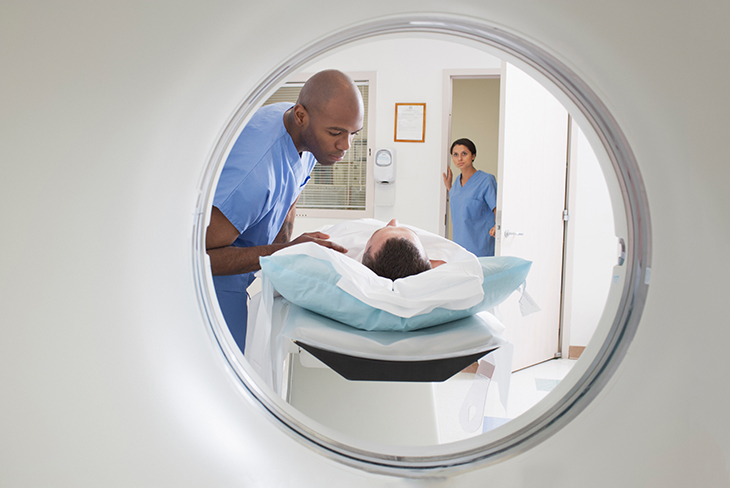Working together to treat a tumour

When it comes to cancer, patient care is a team effort. Life Healthcare takes a multidisciplinary approach, which is crucial to positive clinical outcomes for the patient, from detection to treatment and follow-up.
Discovering the brain tumour
Brain tumours present with various symptoms. These are mainly due either to raised pressure in the head or neurological symptoms that are caused by compression or invasion of brain tissue. ‘Headaches, seizures or stroke-like symptoms often cause patients to see a neurologist first, while blurred or double vision might prompt a visit to an ophthalmologist.
Dr Grant White, a neurosurgeon at Life Vincent Pallotti Hospital, explains: ‘For patients who are known to have other tumours that later spread to the brain, the first contact is often the oncologist they already see. In some cases, the tumour may be picked up incidentally when having a scan for another reason. Many patients will have been referred after starting with their general practitioner for these and other symptoms.’
Referral to a neurologist
‘A neurologist is the first port of call after the patient has consulted a GP. Patients might present with blurred vision, headaches, weakness and slurred speech. The location and size of the tumour plays an important role in how the patient might present. For instance, if the tumour is located in the left side of the brain, the patient might experience difficulty expressing themselves. If the tumour is located in the right side, their visuospatial ability might be affected. Should the tumour be located in the front of the brain, the patient might present with behavioural or personality changes,’ explains Dr Amanullah Rawoot, a neurologist at Life Vincent Pallotti Hospital.
‘Neurologists are clinical specialists who diagnose and manage neurological disorders. If a neurologist suspects a brain tumour, a scan of the brain will confirm the diagnosis. The patient is then referred to a neurosurgeon.’
Meeting the radiologist
When a tumour or an abnormality is detected, the first task of the radiologist is to identify the exact location and extent of the disease, says Dr Christian Stoyanov at Life Empangeni Private Hospital. ‘The radiologist interprets the cross-sectional images of the patient, makes the diagnosis and determines the stage and extent of the disease based on their findings,’ he says.
‘Diagnosis by expert radiologists is based on the extensive knowledge of anatomy, normal variants, pathology and technical principles of the imaging modality. With the technological advances in the field of medical imaging, brain tumour imaging has become an essential component in diagnosis, treatment planning and monitoring treatment response, as well as patient prognosis,’ adds Dr Stoyanov.
Consulting the neurosurgeon
Once the tumour has been confirmed, the neurosurgeon takes on the decision-making regarding further treatment – this is where collaboration with the radiologist and oncologist is essential. ‘Often, the specific diagnosis of the tumour may be made only after surgery when part of the tumour has been provided to the pathologist for microscopic and laboratory analysis,’ says Dr White.
‘The neurosurgeon’s most specific expertise is in the planning and performance of surgery for the brain tumour. This involves balancing the risks of various surgical approaches against their benefits, choosing the right tool for the job and deciding on the specific aim of the surgery, and then doing the procedure as safely and effectively as possible.’ Guiding and educating the patient and family is an essential preparation before any operation; brain tumour surgery is particularly challenging and everyone needs to understand the risks and limitations of surgery, adds Dr Charles Frederick Kieck, a neurosurgeon at Life Vincent Pallotti Hospital.
‘After surgery, the neurosurgeon will continue to look after the patient through their hospitalisation and will refer them for any rehabilitation needed and involve the oncologist where chemotherapy or radiotherapy is appropriate. The neurosurgeon will usually continue to check up on a patient who has had a brain tumour for the rest of their lives.’
Seeing the oncologist
Once the diagnosis has been established, patients are referred to an oncologist for treatment. ‘Secondary brain tumours are often diagnosed by oncologists, as we are following up patients with previously diagnosed cancers, and when they present with brain-associated symptoms we would proceed with a scan. In some cases, we would then refer them to a neurosurgeon if we felt surgery was possible or necessary,’ says Dr Jacqueline May Hall, a clinical oncologist at Life Vincent Pallotti Hospital. ‘We may enlist a neurologist to help us with the management of associated seizures.
‘An oncologist’s role is to perform treatment (obviously other than surgery) as well as oversee, monitor and prescribe any radiotherapy or chemotherapy required. We would also support the patient holistically with, for example, symptom control that includes steroids, analgesia, anti-seizure medication, referral for physiotherapy, occupational therapy or rehabilitation, and would counsel and refer for counselling as needed. We refer patients to hospice as appropriate too.’
The information is shared on condition that readers will make their own determination, including seeking advice from a healthcare professional. E&OE. Life Healthcare Group Ltd does not accept any responsibility for any loss or damage suffered by the reader as a result of the information provided.

